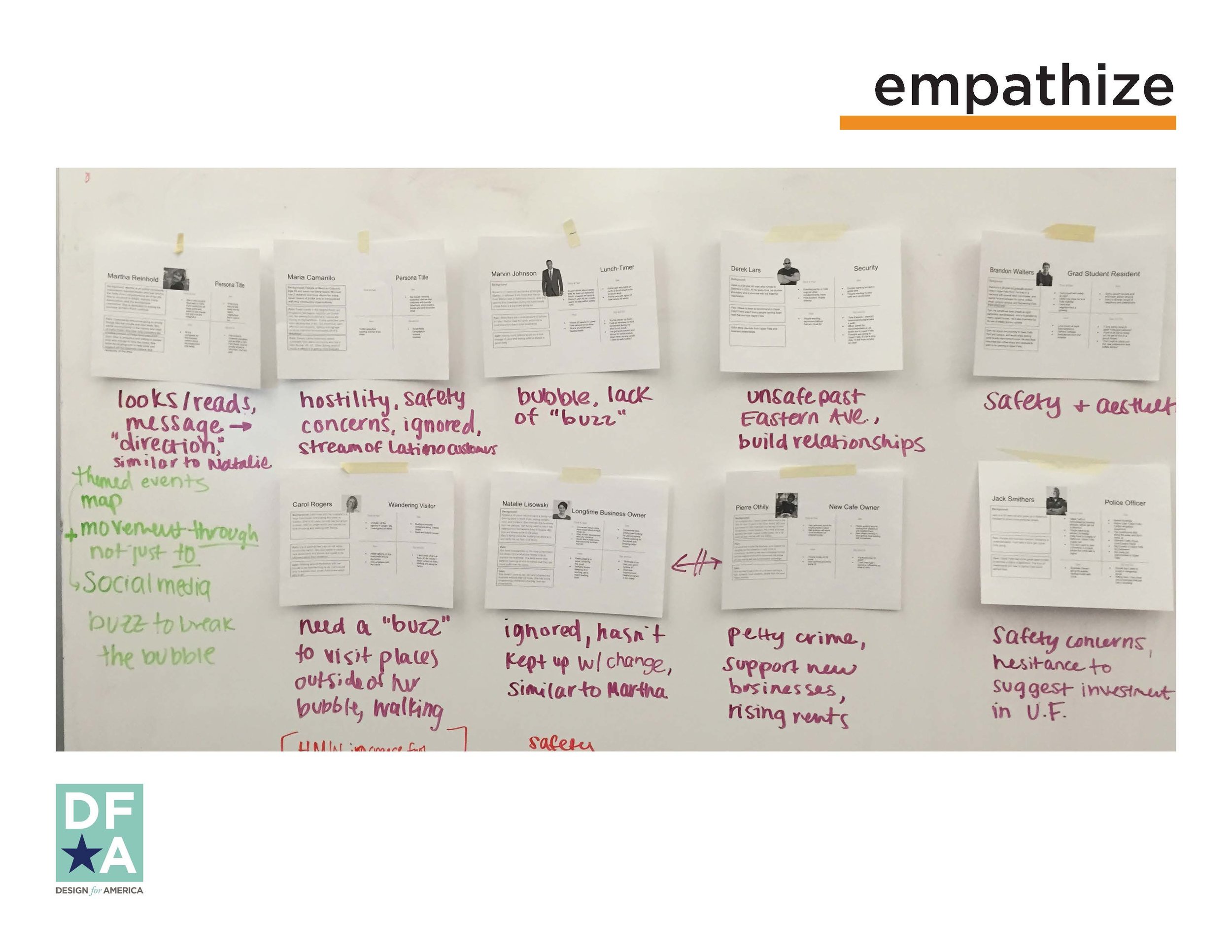Prompt: How can we improve small businesses in the Upper Fells Point neighborhood to draw more foot traffic?
Proposal: Create a business loyalty card, a mobile community park, and a lantern walk to draw people to the neighborhood and encourage them to patronize businesses.
Project of Design For America
Process

Background
While Lower Fells Point is located along an attractive harbor space and bustles with bars and coffee shops, most city residents and tourists do not know about the wealth of diverse and long-standing businesses north of Eastern Avenue. Newly elected City Councilman Zeke Cohen was chosen to represent the large and diverse District 1 in Baltimore and wants to draw people to Upper Fells Point.

Interviews
Although the councilman’s team was enthusiastic about a Business Improvement District (BID) as a potential solution, our team wanted to hear from small business owners directly before proposing any solutions. I went into Upper Fells Point to interview local business owners and met a long time cafe owner, the proprietor of a newly opened Mexican take-out shop, and an investor who was looking to reopen a closed restaurant as part of his investment portfolio. From these interviews, I learned that most business owners were optimistic that the neighborhood would improve over time but were also wary that gentrification would increase rents and attract more competition. They were also concerned about crime in the area and the perception of crime might be deterring more visitors. Two of my interviewees mentioned how upcoming changes to a nearby government housing development could significantly impact the area.



Persona Building + Problem Definition
As a group, we pooled our interviews and developed personas for the types of people we met: A businessman looking for lunch spot in the neighborhood, an owner of a newly-opened cafe, a bouncer at a bar, a Canton resident, a community activist, a bodega owner, a Hopkins student, a police officer, and a long-time resident who inherited the family business. Reflecting on the mix of perspectives, we noticed that there was tension between established and new businesses and there were no active business associations that drew them together. Many interviewees wanted to attract more development and visitors but in a careful way that honored what already existed in the neighborhood and increased the feeling of safety and community. Finally, we noticed that the distinct between “Lower” and “Upper” Fells was not helpful and the area should share both resources and reputation. After absorbing this, we formulated our problem statement as “How might we build a unified network of businesses, forming a safe and vibrant community, to create awareness for one Fells Point?”

Ideation + Prototyping
We used the design criteria of unification, safety, and vibrancy to guide ideating and were able to create nearly three dozen potential solutions. After evaluating them for potential feasibility and impact, we selected three to develop further into concepts that the Councilman’s office could support.

Neighborhood Loyalty Card
Taking inspiration from loyalty cards at frozen yogurt shops and cafes, we expanded the idea to ask, “What if people were rewarded for patronizing several businesses and building loyalty to a neighborhood rather than a specific location?” We knew that there are several new and established coffee shops throughout Fells Point and we could encourage business there by providing a loyalty card and a map that would highlight them. For this concept, cafe owners would consent to be included on a loyalty card and accompanying map. We would recruit ten coffee shops throughout Fells Point to be on the card and visitors would receive a stamp at each location they visited, thus encouraging them to try cafes they had never been to before. When all ten shops had been visited, the customer could turn in the card for a prize at any of the locations. We imagined that the set of ten businesses could shift from year to year, moving from coffee shops to restaurants to antique stores, etc.

Parklet
We took inspiration from San Francisco’s Pavement to Parks initiative to create “parklets” as a way to engage in community building in a diverse neighborhood. Parklets are a small, mobile gathering space for passersby that fits into the size of a standard parking space and when aligned with the curb, allows people to repurpose part of the street into a public space. These small parks provide amenities like seating, planting, bicycle parking, and art. While they are funded and maintained by neighboring businesses, residents, and community organizations, they are publicly accessible and open to all. We designed the parklets to reflect the diversity and creativity of the people and organizations who sponsor and design them. They also reflect the City’s commitment to encouraging walking, bicycling, and strengthening local communities.

Lantern Walk
Baltimore has a strong commitment to public light art as a way to draw people to places, from Hampden’s “Miracle on 34th Street” to the new Light City festival. Artistic light installations add beauty to spaces, increase the feeling of public safety, and draw crowds to wander new neighborhoods. We offered a Fells Point-style lantern walk as a way to draw people to spots all over Fells Point. Using one old-fashioned, port-style lantern as the base, we would distribute these lanterns to local businesses and community groups and have them decorate them. Then, the lanterns would be installed in front of their locations and a map would be produced to advertise the lantern walk to visitors.

Implementation
For each idea, we offered implementation plans that included timelines, potential community partners, technical specifications, and potential funding sources. We presented our ideas to a group of Fells Point business owners and each was received well. In the end, Councilman Cohen’s office was able to move forward with the parklet concept and they are now being built by Mahon Rykiel Associates and PI.Kl Studio.
